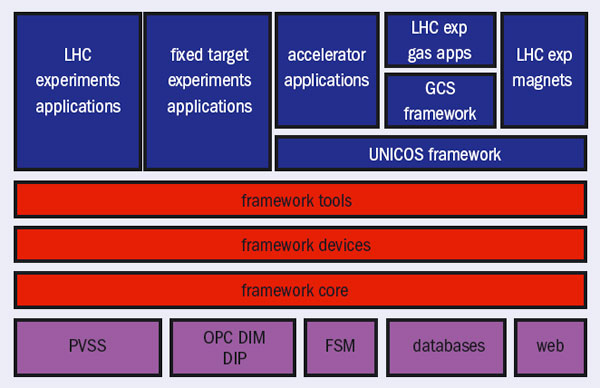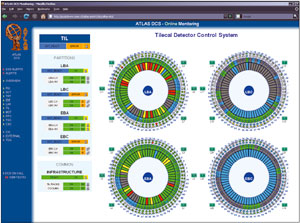Wayne Salter explains the basis for a new collaborative approach
Traditionally at CERN, teams on each experiment, and in some cases each subdetector, have independently developed a detector-control system (DCS) – sometimes known as “slow controls”. This was still the case for the experiments at LEP. However, several factors – the number and geographical distribution of development teams, the size and complexity of the systems, limited resources, the long lifetime (20 years) and the perceived similarity between the required systems – led to a change in philosophy. CERN and the experiments’ management jointly decided to develop, as much as possible, a common DCS for the LHC experiments. This led to the setting up in 1997 of the Joint Controls Project (JCOP) as a collaboration between the controls teams on the LHC experiments and the support groups in CERN’s information technology and physics departments.
The early emphasis in JCOP was on the difficult task of acquiring an understanding of the needs of the experiments and agreeing on common developments and activities. This was a period where disagreements were most prevalent. However, with time the collaboration improved and so did progress. Part of this early effort was to develop a common overall architecture that would become the basis of many of the later activities.
The role of JCOP
In parallel, the JCOP team undertook evaluations to assess the suitability of a number of technologies, primarily commercial ones, such as OLE for Process Control (OPC), the field buses CANBus and ProfiBus, commercial programmable logic controllers (PLCs), as well as supervisory control and data acquisition (SCADA) products. The evaluation of SCADA products eventually led to the selection of the Prozessvisualisierungs und Steuerungs System (PVSS) tool as a major building block for the DCS for experiments. The CERN Controls Board subsequently selected PVSS as the recommended SCADA system for CERN. In addition, and where suitable commercial solutions were not available, products developed at CERN were also evaluated. This led to JCOP’s adoption and support of CERN’s distributed information manager (DIM) middleware system and the SMI++ finite-state machine (FSM) toolkit. Furthermore, developments made in one experiment were also adopted by other experiments. The best example of this is the embedded local monitor board (ELMB) developed by ATLAS. This is a small, low-cost, high-density radiation-tolerant input/output card that is now used extensively in all LHC experiments, as well as in some others.

One major thrust has been the development of the so-called JCOP framework (FW) (figure 1). Based on specifications agreed with the experiments, this provides a customized layer on top of the technologies chosen, such as PVSS, SMI++ and DIM. It offers many ready-to-use components for the control and monitoring of standard devices in the experiments (e.g. CAEN high voltage, Wiener and CAEN low voltage, the ELMB and racks). The FW also extends the functionality of the underlying tools, such as the configuration database tool and installation tool.
These developments were not only the work of the CERN support groups but also depended on contributions from the experiments. In this way the development and maintenance was done once and used by many. This centralized development has not only significantly reduced the overall development effort but will also ease the long-term maintenance – an issue typically encountered by experiments in high-energy physics where short-term collaborators do much of the development work.
As figure 1 shows, the JCOP FW has been developed in layers based on a component model. In this way each layer builds on the facilities offered by the layer below, allowing subdetector groups to pick and choose between the components on offer, taking only those that they require. The figure also illustrates how the JCOP FW, although originally designed and implemented for the LHC experiments, can be used by other experiments and applications owing to the approach adopted. Some components in particular have been incorporated into the unified industrial control system (UNICOS) FW, developed within the CERN accelerator controls group (Under control: keeping the LHC beams on track). The UNICOS FW, initially developed for the LHC cryogenics control system, is now used for many applications in the accelerator domain and as the basis for the gas-control systems (GCS) for the LHC experiments.
In addition to these development and support activities, JCOP provides an excellent forum for technical discussions and the sharing of experience across experiments. There are regular meetings, both at the managerial and the technical levels, to exchange information and discuss issues of concern for all experiments. A number of more formal workshops and reviews have also taken place involving experts from non-LHC experiments to ensure the relevance and quality of the products developed. Moreover, to maximize the efficiency and use of PVSS and the JCOP FW, JCOP offers tailor-made training courses. This is particularly important because the subdetector-development teams have a high turnover of staff for their controls applications. To date, several hundred people have attended these courses.
As experiments have not always tackled issues at the same time, this common approach has allowed them to benefit from the experience of the first experiment to address a particular problem. In addition, JCOP has conducted a number of test activities, which cover the testing of commonly used commercial applications, such as various OPC servers, as well as the scalability of many of the supported tools. Where the tests indicated problems, this provided feedback for the tool developers, including the commercial suppliers. This in turn resulted in significant improvements in the products.

Building on the framework
Although JCOP provides the basic building blocks and plenty of support, there is still considerable work left for the subdetector teams around the world who build the final applications. This is a complex process because there are often several geographically distributed groups working on a single subdetector application, and all of the applications must eventually be brought together and integrated into a single homogeneous DCS. For this to be possible, the often small central experiment controls teams play a significant role (figure 2). They not only participate extensively in the activities of JCOP, but also have other important tasks to perform, including development of guidelines and recommendations for the subdetector developments, to ensure easy integration; customization and extension of the JCOP FW for the experiment’s specific needs (e.g. specific hardware used in their experiment but not in the others); support and consultation for the subdetector teams; development of applications for the monitoring and control of the general experiment infrastructure e.g. for the control of racks and environmental monitoring.
As well as selecting, developing and supporting tools to ease the development of the DCSs, there have been two areas where complete applications have been developed. These are the detector safety systems (DSS) and the gas control systems (GCS). The DSS, which is based on redundant Siemens PLCs and PVSS, has been developed in a data-driven manner that allows all four LHC experiments to configure it to their individual needs. Although not yet fully configured, the DSS is now deployed in the four experiments and has been running successfully in some for more than a year.
The approach for the GCS goes one step further. It is also based on PLCs (Schneider Premium) and PVSS, but the PLC and PVSS code of the 23 GCSs is generated automatically using a model-based development technique. In simple terms, there is a generic GCS model that includes all possible modules and options, and each GCS application is defined by a particular combination of these modules and options. The final GCS application is created by selecting from a set of predefined components and configuring them appropriately using an application builder created for the purpose. All 23 GCSs have been generated in this way and are now deployed.

At the time of writing, the four LHC experiment collaborations were all heavily engaged in the commissioning of their detectors and control systems. To date, the integration of the various subdetector-control systems has proceeded relatively smoothly, owing to the homogeneous nature of the subdetector implementations. However, that is not to say that it has been problem free. Some issues of scaling and performance have emerged as the systems have increased in size, with more and more of the detectors being commissioned. However, thanks to the JCOP collaboration, it has been possible to address these issues in common for all experiments.
Despite some initial difficulties, the players involved see the approach described in this article, as well as the JCOP collaboration, as a success. The key here has been the building of confidence between the central team and its clients through the transparency of the procedures used to manage the project. All of the partners need to understand what is being done, what resources are available and that the milestones will be adhered to. The benefits of this collaborative approach include less overall effort, through the avoidance of duplicate development; each central DCS and subdetector team can concentrate on their own specific issues; easier integration between developments; sharing of knowledge and experience between the various teams; and greater commonality between the experiment systems enables the provision of central support. In addition, it is easier to guarantee long-term maintenance with CERN-based central support. Compared with previous projects, JCOP has led to a great deal of commonality between the LHC experiments’ DCSs, and it seems likely that with more centralized resources even more could have been achieved in common.
Could the JCOP approach be applied more widely to other experiment systems? If the project has strong management, then I believe so. Indeed, the control system based on this approach for the LHCb experiment is not limited to the DCS but also covers the complete experiment-control system, which includes the trigger, data-acquisition and readout systems as well as the overall run control. Only time will tell if this approach can, and will, be applied more extensively in future projects.








